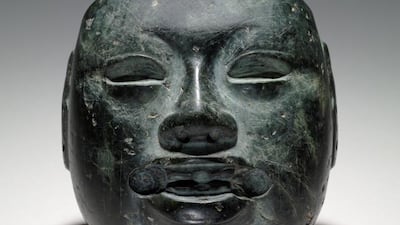What do a bronze hand from Yemen, a 3,000-year-old statue of an Egyptian Pharaoh and a car that can be driven only with your feet have in common?
The first part of the answer is that they are all arriving in Abu Dhabi at the end of next month.
The second is that they and 97 other artefacts form the latest exhibition from the British Museum — a collection is designed to whet the appetite for the opening of the Zayed National Museum.
This will be the third exhibition organised by the British Museum, which is the consultant for the launch of the Zayed National Museum, due to be up and running in 2016.
It is also the most unusual and perhaps the most ambitious. Entitled A History of the World In 100 Objects it will do just that, with an emphasis on works ancient and contemporary that have shaped life as we know it.
The exhibition will open at Manarat Al Saadiyat on April 23 and run to August 2 — exactly 100 days.
As a concept, the exhibition is based on a massively popular radio series that was a collaboration between the British Museum and the BBC in 2010.
The 100 objects spanned human civilisation from a 2 million-year-old hand axe found in what is now Tanzania to a Sharia-compliant credit card issued by HSBC in the UAE.
The radio series was presented by Neil MacGregor, the museum’s director, who will be coming to Abu Dhabi to give a lecture on the eve of the exhibition’s opening.
Objects such as those coming to Abu Dhabi “have a tremendous power and ability to tell stories”, says Mr MacGregor.
“In many instances they are the only evidence we have for certain cultures, so these kinds of temporary exhibitions, and indeed the permanent displays in the Zayed National Museum, are hugely important to aid our understanding of the world.”
______________________________
To mark the 40th anniversary of the founding of the UAE, The National created a series that tells the story of the nation through 40 objects. Inspired by the original History of the World in 100 Objects, it include items from a Quran used by Sheikh Zayed, the first President of the UAE, to a pearl diver's nose clip and one of the first Etisalat mobile phones. To see the complete collection, click here
______________________________
This new collection, presented through the Abu Dhabi Tourism and Culture Authority (TCA Abu Dhabi), places an emphasis on themes that will be present in the Zayed National Museum, including faith and Islam, science, learning and heritage.
Details of some of the collection were revealed yesterday at the exhibition’s announcement. They include a lifelike cast bronze hand from Yemen that was made between 100 and 300AD and is part of a selection that represents ritual and belief.
The museum believes the right hand is a symbol of good fortune to ward off evil. It was made as an offering to a pre-Islamic god for display in a temple.
From Egypt comes a granite statue of Ramesses II discovered on Elephantine Island as part of the Temple of Khnum. The carving shows the king wearing a false beard, which was the style of the time, and the two crowns of Upper and Lower Egypt.
One of the most intriguing displays will be the Royal Game of Ur, found in a royal cemetery in southern Iraq and estimated to be nearly 4,500 years old.
The game features 20 squares made of carved shell with red limestone and lapis lazuli. Ancient documents show the game involved two players racing across their pieces across the board.
Even older is a burnt bowl made in what is now northern Iraq up to 7,500 years ago, with the introduction of cattle farming.
Two of the most stunning objects are also among the smallest. Less than 6 centimetres tall, they are gold statuettes from the fabulous Oxus treasure, discovered near the Oxus river on the border of Afghanistan and Tajikistan in the 19th century. The figures were made in the time of Cyrus the Great, about 530BC.
Outside the Middle East are 1,000-year-old ivory gaming pieces from Germany, a Hebrew astrolabe, a scientific instrument made in Spain in the 14th century under Islamic rule and a Chinese burial figure from the tomb of an 8th century military commander.
As for the car that can driven with feet alone, it will be one of largest and recent items, as well as perhaps the closest to home.
It is the invention of Reem Al Marzouqi, a 23-year-old student at UAE University in Al Ain. The car can be steered with feet because it was designed for people with no arms, and has been awarded a patent in the United States.
Ms Al Marzouqi worked on the prototype in her own time, inspired by the story of Jessica Cox, a handicapped pilot from the US whose driving licence was suspended due to her disability.
Interviewed by The National last November, Ms Marzouqi said: “I failed many times and a lot of people laughed at me when I was talking about it at the beginning.
“If you have an idea and you believe in it, just do it, go for it.”
The exhibition will be supported by a public programme of tours and workshops.
Sheikh Sultan bin Tahnoon Al Nahyan, chairman of TCA, called the exhibition “another important milestone in Abu Dhabi’s developing cultural scene as it builds momentum and inspires interest in the country’s first national federal museum, while placing the history of the UAE and its cultural significance within the context of the world”.
Three museums are planned for the first stage of the Saadiyat Island Cultural District. The Louvre Abu Dhabi will be the first to open, next year, followed by the Zayed National Museum and the Guggenheim Abu Dhabi.
jlangton@thenational.ae


